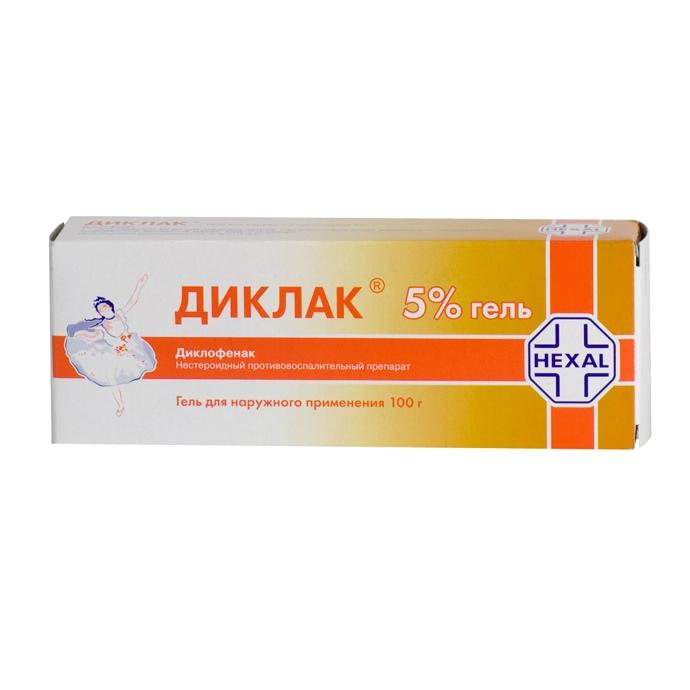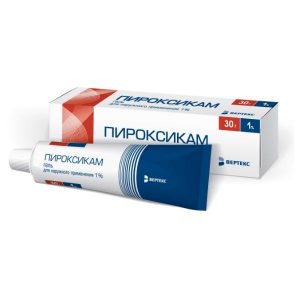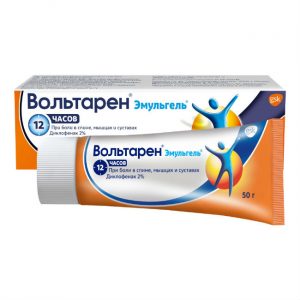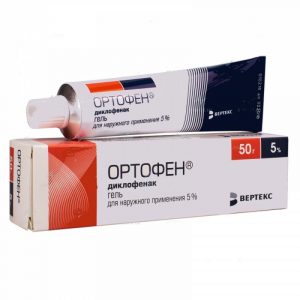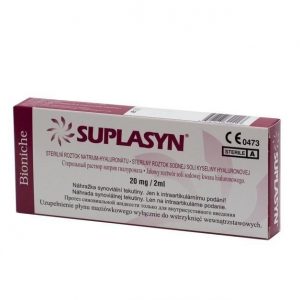Description
Latin name
Diclac
Release form
Gel for external use
tube 100 g packaging
Pharmacological action
The active ingredient diclofenac is a non-steroidal anti-inflammatory drug (NSAID) with pronounced analgesic and anti-inflammatory properties.
Indiscriminately inhibiting type 1 and 2 cyclooxygenase (COX 1 and COX 2), disrupts the metabolism of arachidonic acid and the synthesis of prostaglandins, which are the main link in the development of inflammation.
Diclofenac is used to relieve inflammation and eliminate pain, as well as reduce swelling associated with the inflammatory process.
Pharmacokinetics
With the recommended method of application, no more than 6% of diclofenac is absorbed. When applied to the affected joint, the concentration in the synovial fluid is higher than in the blood plasma.
Selected patient groups
In patients with impaired renal function, diclofenac and its metabolites do not accumulate.
In patients with chronic hepatitis or subcompensated cirrhosis, the pharmacokinetics and metabolism of diclofenac are comparable to those in healthy patients.
Indications
• Diseases of the musculoskeletal system: rheumatoid arthritis, psoriatic arthritis, ankylosing spondylitis, osteoarthritis of the peripheral joints and spine rheumatic soft tissue lesions.
• Muscle pains of rheumatic and non-rheumatic origin.
• Traumatic soft tissue injuries.
Contraindications
Hypersensitivity to diclofenac or other components of the drug, acetylsalicylic acid or other NSAIDs, “aspirin” asthma, pregnancy (III trimester), lactation, children (up to 6 years), violation of the integrity of the skin.
Precautions: hepatic porphyria (exacerbation), erosive and ulcerative lesions of the gastrointestinal tract, severe impaired liver and kidney function, chronic heart failure, asthma, old age, pregnancy I and II trimester.
Use during pregnancy and lactation
The drug cannot be used in the III trimester of pregnancy. There is no experience with the use of the drug Diklak В® during lactation.
Use in the I and II trimesters is possible only after consultation with a doctor.
Composition
100 g of the preparation contains: active substance: diclofenac sodium – 5.0 g
excipients: isopropyl alcohol – 45.0 g purified water – 40.8 g macrogol-7-glycerol cocoate – 6.0 g hypromellose – 3.0 g aromatic oil “Bouquet” WN 4507 – 0.2 g.
Dosage and Administration
Externally. For adults and children over 6 years of age, the drug is applied to the skin 2-3 times a day and rubbed lightly. The required amount of the drug depends on the size of the painful area. A single dose of the drug is up to 2 g (about 4 cm with the neck of the tube fully open). After applying the drug, hands should be washed. The duration of treatment depends on the indications and the observed effect. After 2 weeks of using the drug, consult your doctor.
Side effects of
According to the WHO, adverse reactions are classified according to their frequency of development as follows:
very often ( 1/10)
often ( 1/100, <1/10) infrequently ( 1/1000, <1/100) rarely ( 1/10000, <1/1000) very rare (<1/10000) frequency is unknown – according to the available data, it was not possible to establish the frequency of occurrence. From the hemopoietic system: very often – anemia, leukopenia, neutropenia, thrombocytopenia, lymphopenia often – febrile neutropenia (including grade 3-4), sepsis with neutropenia rarely – granulocytopenia, hemolytic anemia, immune thrombocytopenia. From the nervous system: very often – peripheral sensory neuropathy, sensory disturbances, headache, asthenia, taste disturbance often – dizziness, meningism, depression, insomnia infrequently – increased nervousness rarely – dysarthria, posterior reversible leukoencephalopathy syndrome. Neurotoxicity is a dose-limiting factor. Often, symptoms of sensory neuropathy are triggered by a cold. The duration of these symptoms, which usually stop between the courses, increases depending on the total dose of oxaliplatin. Functional disturbances in the form of difficulty in performing precise movements are possible consequences of sensory damage. The risk of functional disorders with a total dose of about 850 mg / m2 (10 cycles) is about 10%, reaching 20% in the case of a total dose of 1020 mg / m2 (12 cycles). In most cases, the severity of neurological symptoms is reduced or completely stopped. In 3% of patients, 3 years after the end of treatment, either stable local paresthesia of moderate intensity (2.3%) or paresthesia affecting functional activity (0.5%) was observed. During treatment with oxaliplatin, acute sensorineural manifestations were noted, which usually occurred within a few hours after drug administration and were most often triggered by exposure to cold. They were characterized by transient paresthesia, dysesthesia or hypesthesia, rarely (1-2%) – acute laryngeal pharyngeal dysesthesia syndrome. The latter was manifested by a subjective feeling of dysphagia and shortness of breath without objective signs of respiratory distress syndrome (cyanosis or hypoxia), or spasm of the larynx, or bronchospasm (without stridor or wheezing). Also observed were spasm of the jaw muscles, tongue dysesthesia, dysarthria and a feeling of pressure in the chest. Typically, these symptoms quickly stopped both without the use of drug therapy, and with the introduction of antihistamines and bronchodilators. An increase in the duration of infusion during subsequent cycles of oxaliplatin therapy can reduce the frequency of this syndrome. On the part of the sensory organs: often – conjunctivitis, visual impairment infrequently – ototoxicity rarely – transient decrease in visual acuity, loss of visual fields, hearing loss, auditory nerve neuritis, optic neuritis, deafness. From the respiratory system: very often – cough, shortness of breath often – rhinitis, upper respiratory tract infection, pain in the chest area rarely – pulmonary fibrosis, intestinal lung disease, sometimes with the development of a fatal outcome. From the digestive system: very often – nausea, vomiting, diarrhea, stomatitis, mucositis, abdominal pain, constipation, loss of appetite, increased levels of alkaline phosphatase, activity of liver enzymes, bilirubin content, LDH often – dyspepsia, hiccups, gastroesophageal reflux, bleeding from the gastrointestinal tract (including from the rectum) infrequently – intestinal obstruction, paralytic ileus rarely – colitis, including cases of pseudomembranous colitis, pancreatitis is very rare – obliterating endophlebitis of the hepatic veins, incl. hepatic purpura, nodal regenerative hyperplasia, perisinusoidal fibrosis, which clinically can manifest itself in the form of signs of portal hypertension and / or an increase in the activity of hepatic transaminases. From the urinary system: often – hematuria, dysuria, a change in the frequency of urination, an increase in the concentration of creatinine in the blood plasma is very rare – hemolytic-uremic syndrome, acute tubular (tubular) necrosis, acute interstitial nephritis, acute renal failure. From the skin and subcutaneous tissues: very often – alopecia, skin rashes often – peeling of the skin of the hands and feet, erythematous rashes, excessive sweating, changes in the nails. From the musculoskeletal system: very often – back pain often – arthralgia, bone pain. From the side of metabolism: very often – anorexia, hyperglycemia, hypokalemia, hyponatremia often – dehydration infrequently – metabolic acidosis. From the cardiovascular system: often – pain behind the sternum, deep vein thrombophlebitis, pulmonary thromboembolism, bleeding, increased blood pressure, flushing of the face. Allergic reactions: rarely (when used as monotherapy) or often (in combination with 5-fluorouracil +/- calcium folinate) bronchospasm, angioedema, hypotension, and anaphylactic shock may occur. Often there have been cases of allergic manifestations such as skin rashes (especially urticaria), conjunctivitis or rhinitis. Local reactions: with extravasation of the drug, pain and inflammatory reactions at the injection site. Other: very often – increased body temperature, increased fatigue, increased body weight, asthenia. hypersensitivity (including urticaria, angioedema, bronchospasm). From the respiratory system is very rare: bronchial asthma. From the skin and subcutaneous tissue often: dermatitis (including contact dermatitis), erythema, eczema, hypersensitivity (including urticaria, angioedema, bronchospasm). From the respiratory system is very rare: bronchial asthma. From the skin and subcutaneous tissue often: dermatitis (including contact dermatitis), erythema, eczema,e, swelling of the treated area of the skin, rash (papules, vesicles), peeling rarely: bullous dermatitis, pustular rashes very rarely: photosensitivity, generalized skin rash. Drug Interaction With Diclac with Digoxin, phenytoin or lithium drugs may increase the plasma concentrations of these drugs with diuretics and antihypertensives – may reduce the effect of these drugs with potassium-sparing diuretics – may develop hyperkalemia with acetylsalicylic acid – decrease the concentration of diclofenac in plasma effects. Diclofenac may increase the toxic effect of cyclosporine on the kidneys. Diclofenc can cause hypo- or hyperglycemia, so blood glucose monitoring is required when used concomitantly with hypoglycemic agents. When using methotrexate for 24 hours before or after taking Diclofenac, it is possible to increase the concentration of methotrexate and increase its toxic effect. When co-administered with anticoagulants, regular monitoring of blood coagulation is required. overdose Extremely low systemic absorption of the active component of the drug when used externally makes overdose almost impossible. Storage conditions Store in a dry, dark place at a temperature of no higher than 25 C. Expiration 3 years. Deystvuyuschee substances Diclofenac Dosage form dosage form gel for external use Sandoz, Switzerland
